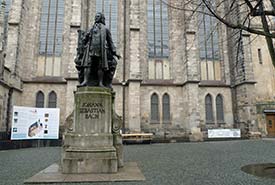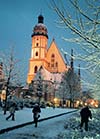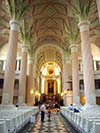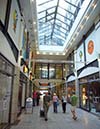|
Europe
> Germany >
Leipzig > Sightseeing, shopping
Leipzig Travel and Tourist Information
Page 2
Continued from page 1

ABOVE: A Johann Sebastian Bach statue next
to the Thomaskirche. INSET BELOW: The Thomaskirche in winter, the Nikolaikirche,
a downtown shopping street, and the Brühl Arkade.
 Sightseeing Sightseeing
Leipzig's major sights are easy to see on foot: The city center
covers only 1 square kilometer, or less than 0.4 square mile, and most of the
places you're likely to visit are either in the center or close by.
 Top
attractions include the
Thomaskirche, where Bach wrote his most important choral and organ works,
and where Martin Luther intrduced the Reformation to Leipzig in 1519; the
Nikolaikirche,
Leipzig's oldest church and the site of "peace prayers" during the GDR years
that led to the Monday Demonstrations of 1989; the Altes Rathaus, or Old
City Hall, which houses the Museum of City History and faces the Marktplatz
or Market Square and the Old Stock Exchange; the
Opera House; and the Gewandhaus,
home of Leipzig's symphony orchestra. Top
attractions include the
Thomaskirche, where Bach wrote his most important choral and organ works,
and where Martin Luther intrduced the Reformation to Leipzig in 1519; the
Nikolaikirche,
Leipzig's oldest church and the site of "peace prayers" during the GDR years
that led to the Monday Demonstrations of 1989; the Altes Rathaus, or Old
City Hall, which houses the Museum of City History and faces the Marktplatz
or Market Square and the Old Stock Exchange; the
Opera House; and the Gewandhaus,
home of Leipzig's symphony orchestra.
For more information on sightseeing opportunities in Leipzig,
visit the city's tourist office or browse its Web site (see hours of operation
and links on our Leipzig Tourist Office
page.)
Shopping
 Leipzig's city center is a lively place for shoppers, with
branches of major German department stores and clothing chains as well as
locally-owned shops. The
Promenaden Hauptbahnhof
Leipzig shopping mall in the main railroad station is also a great place for
shopping--especially late in the evening or on Sundays, when most other stores
in the city are closed. Leipzig's city center is a lively place for shoppers, with
branches of major German department stores and clothing chains as well as
locally-owned shops. The
Promenaden Hauptbahnhof
Leipzig shopping mall in the main railroad station is also a great place for
shopping--especially late in the evening or on Sundays, when most other stores
in the city are closed.
But the most unique shopping experience in Leipzig is beneath
the glass roofs of the covered passages and courtyards in the city center. Many
of these structures were built as "exhibition palaces" in the mid-1890s, when
merchants began displaying their goods at sample fairs.
Only
13 of the original passages remained after World War II, but the number has
grown back to about 30 in recent years.
 The site of the modern Brühl
Arkade (inset photo) was once the hub of Leipzig's fur trade, while the
Mädlerpassage (an
arcade on top of a celebrated historic tavern,
Auerbachs Keller) was built from 1912-1914. The oldest surviving historic
passage, Barthels Hof, has been home to the
Gasthaus Barthels Hof restaurant since 1890. The site of the modern Brühl
Arkade (inset photo) was once the hub of Leipzig's fur trade, while the
Mädlerpassage (an
arcade on top of a celebrated historic tavern,
Auerbachs Keller) was built from 1912-1914. The oldest surviving historic
passage, Barthels Hof, has been home to the
Gasthaus Barthels Hof restaurant since 1890.
Next page:
Museums, parks
1st inset photo copyright © LTS-Kühne.
2nd inset photo copyright © LTS-Schmidt.
|